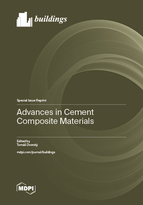Advances in Cement Composite Materials
A special issue of Buildings (ISSN 2075-5309). This special issue belongs to the section "Building Materials, and Repair & Renovation".
Deadline for manuscript submissions: closed (30 November 2023) | Viewed by 18688
Special Issue Editor
Interests: cement; raw material; cement composite; concrete; recycling; environmental engineering
Special Issue Information
Dear Colleagues,
Concrete, in the sense of a cement composite consisting of filler, binder, and water, is one of the main building materials of the past, as well as the modern history of mankind. At present, the area of cement composites or concretes is going through a period of a relatively rapid development. The efforts of researchers around the world are focused on the development of new additives and admixtures that affect the final properties of fresh and hardened concrete. Another relatively strong group are scientists dealing with the replacement of natural aggregates with various secondary materials or by-products (waste materials) from industrial production in order to protect the natural resources of aggregates. The resulting cement composites use the historically proven properties of concrete, but, at the same time, this new material has added value in the form of reduction of waste production. When suitable components are used, the so-called eco-friendly cement composites with minimal negative impact on the environmental can be produced.
The aim of this Special Issue is to publish the current advances in the field of cement composite materials not only based on ordinary portland cement (OPC) and natural aggregates, but also in the field of other materials incorporated into the cement matrix. The field of cement composites is very wide and this Special Issue provides a unique opportunity to present the latest knowledge in this field of research, development, and application.
We are pleased to invite you to present your research and development outcomes in the form of research articles or reviews in the following areas:
- Eco-friendly cement composites;
- Self-healing concretes;
- High performance concretes;
- Polymer or geopolymers concretes;
- Fiber-reinforced concrete or biocomposites;
- Cement composites based on secondary raw materials;
- Properties of cement composites (physical, mechanical, durability, structures etc.);
- Life cycle assessment of cement composites.
More examples of Special Issues of Buildings at:
https://www.mdpi.com/journal/buildings/special_issues
Dr. Tomáš Dvorský
Guest Editor
Manuscript Submission Information
Manuscripts should be submitted online at www.mdpi.com by registering and logging in to this website. Once you are registered, click here to go to the submission form. Manuscripts can be submitted until the deadline. All submissions that pass pre-check are peer-reviewed. Accepted papers will be published continuously in the journal (as soon as accepted) and will be listed together on the special issue website. Research articles, review articles as well as short communications are invited. For planned papers, a title and short abstract (about 100 words) can be sent to the Editorial Office for announcement on this website.
Submitted manuscripts should not have been published previously, nor be under consideration for publication elsewhere (except conference proceedings papers). All manuscripts are thoroughly refereed through a single-blind peer-review process. A guide for authors and other relevant information for submission of manuscripts is available on the Instructions for Authors page. Buildings is an international peer-reviewed open access monthly journal published by MDPI.
Please visit the Instructions for Authors page before submitting a manuscript. The Article Processing Charge (APC) for publication in this open access journal is 2600 CHF (Swiss Francs). Submitted papers should be well formatted and use good English. Authors may use MDPI's English editing service prior to publication or during author revisions.
Keywords
- eco-friendly cement composites
- self-healing concretes
- high performance concretes
- polymer or geopolymers concretes
- fiber-reinforced concrete or biocomposites
- cement composites based on secondary raw materials
- properties of cement composites
- life cycle assessment of cement composites






